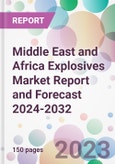Explosives, primarily used for blasting in mining, construction, and quarrying operations, have become indispensable tools in the modern industrial landscape. In the Middle East and Africa, where mineral-rich terrains are abundant, explosives play a pivotal role in the extraction of precious minerals, metals, and other natural resources. Beyond their traditional usage, explosives are also integral to numerous military and defence operations, given the region's geopolitical climate.
A primary factor bolstering the Middle East and Africa explosives market demand is the consistent growth in mining activities. Countries like South Africa, which boasts vast reserves of gold, platinum, and diamonds, rely heavily on explosives for efficient mineral extraction. Similarly, countries in the Middle East, while primarily known for oil, are also diversifying into mineral mining, augmenting the demand for high-quality explosives.
The construction and infrastructural boom in the region further fuel the Middle East and Africa explosives market expansion. As countries like the UAE, Saudi Arabia, and Qatar steer towards diversification strategies, emphasising non-oil sectors, there is a discernible shift towards large-scale construction projects. These initiatives, ranging from skyscrapers to intricate road networks, necessitate the extensive use of explosives for foundation laying and other related activities.
However, the application of explosives isn't limited to civil sectors alone. The Middle East, known for its geopolitical complexities, has a steady demand for military-grade explosives. Defence departments and military factions invest significantly in advanced explosives for both strategic operations and security measures, further enriching the market ecosystem.
An emerging Middle East and Africa explosives market trend is the integration of technology. Digital detonation solutions and precision explosion mechanisms, powered by AI and IoT, are becoming increasingly popular. These technological advancements not only enhance the safety profile of explosive operations but also ensure maximum efficiency, minimising resource wastage.
The sustainability paradigm is also shaping the Middle East and Africa explosives market outlook. As environmental concerns gain prominence, there's a marked shift towards eco-friendly explosives, which have minimal ecological repercussions. Manufacturers are actively seeking alternatives to traditional nitrate-based explosives, emphasising cleaner and greener explosive solutions.
Market Segmentation
The market can be divided based on type, end use, and country.
Market Breakup by Type
- Emulsion
- Dry Blasting
- Non-Electric Capsule
- Seismic
- Others
Market Breakup by End Use
- Mining
- Coal Mining
- Metal Mining
- Quarrying and Non-Metal
- Others
- Construction
- Defence
- Others
Market Breakup by Country
- Saudi Arabia
- United Arab Emirates
- Nigeria
- South Africa
- Egypt
- Iran
- Others
Competitive Landscape
The report looks into the market shares, plant turnarounds, capacities, investments, and mergers and acquisitions, among other major developments, of the leading companies operating in the Middle East and Africa explosives market. Some of the major players explored in the report are as follows:- AECI Limited
- Orica Limited
- OMNIA Group (BME)
- ENAEX Group
- Saudi Chemical Company
- Al Fajar Al Alamia Co. SAOG
- Explosive Industries Ltd.
- Nigachem Nigeria Limited
- Others
Table of Contents
Companies Mentioned
- AECI Limited
- Orica Limited
- OMNIA Group (BME)
- ENAEX Group
- Saudi Chemical Company
- Al Fajar Al Alamia Co. SAOG
- Explosive Industries Ltd.
- Nigachem Nigeria Limited
Methodology

LOADING...








